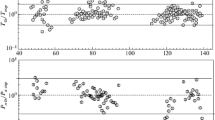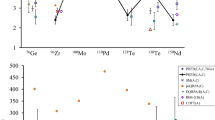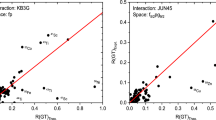Abstract
Effects of finite-range tensor force on \(\beta \)-decay of magic and semimagic nuclei of \(^{34}\)Si, \(^{68,78}\)Ni, and \(^{132}\)Sn have been investigated using the self-consistent Hartree–Fock plus random-phase approximation model. The tensor force shifts the low-lying Gamow–Teller states downward and systematically improves the calculations of Q and \(\log {ft}\) values. Consequently, it systematically reduces the deviations between the theoretical and experimental data and significantly improves the calculation of \(\beta \)-decay half-lives. This effect is similar to that of zero-range tensor force.



Similar content being viewed by others
References
E.M. Burbidge, G.R. Burbidge, W.A. Fowler et al., Synthesis of the elements in stars. Rev. Mod. Phys. 29, 547 (1957). https://doi.org/10.1103/RevModPhys.29.547
J.J. Cowan, F.-K. Thielemann, J.W. Truran, The R-process and nucleochronology. Phys. Rep. 208, 267 (1991). https://doi.org/10.1016/0370-1573(91)90070-3
H.-L. Liu, D.-D. Han, P. Ji et al., Reaction rate weighted multilayer nuclear reaction network. Chin. Phys. Lett. 37, 112601 (2020). https://doi.org/10.1088/0256-307X/37/11/112601
M. Ji, C. Xu, Quantum anti-zeno effect in nuclear $\beta $ decay. Chin. Phys. Lett. 38, 032301 (2021). https://doi.org/10.1088/0256-307X/38/3/032301
K. Takahashi, M. Yamada, Gross theory of nuclear \(\beta \)-decay. Prog. Theor. Phys. 41, 1470 (1969). https://doi.org/10.1143/PTP.41.1470
T. Tachibana, M. Yamada, Y. Yoshida, Improvement of the gross theory of \(\beta \)-decay. II: one-particle strength function. Prog. Theor. Phys. 84, 641 (1990). https://doi.org/10.1143/ptp/84.4.641
K. Langanke, G. Martínez-Pinedo, Shell-model calculations of stellar weak interaction rates: II. Weak rates for nuclei in the mass range \(A=45-61\) in supernovae environments. Nucl. Phys. A 673, 481 (2000). https://doi.org/10.1016/S0375-9474(00)00131-7
G. Martínez-Pinedo, K. Langanke, Shell-model half-lives for \(N=82\) nuclei and their implications for the \(r\) process. Phys. Rev. Lett. 83, 4502 (1999). https://doi.org/10.1103/PhysRevLett.83.4502
J.J. Cuenca-García, G. Martínez-Pinedo, K. Langanke et al., Shell model half-lives for \(r\)-process \(N=82\) nuclei. Eur. Phys. J. A 34, 99 (2007). https://doi.org/10.1140/epja/i2007-10477-3
T. Suzuki, T. Yoshida, T. Kajino et al., \(\beta \) decays of isotones with neutron magic number of \(N=126\) and \(r\)-process nucleosynthesis. Phys. Rev. C 85, 015802 (2012). https://doi.org/10.1103/PhysRevC.85.015802
Q. Zhi, E. Caurier, J.J. Cuenca-García et al., Shell-model half-lives including first-forbidden contributions for \(r\)-process waiting-point nuclei. Phys. Rev. C 87, 025803 (2013). https://doi.org/10.1103/PhysRevC.87.025803
J. Krumlinde, P. Möller, Calculation of Gamow–Teller \(\beta \)-strength functions in the rubidium region in the RPA approximation with Nilsson-model wave functions. Nucl. Phys. A 417, 419 (1984). https://doi.org/10.1016/0375-9474(84)90406-8
P. Möller, J. Randrup, New developments in the calculation of \(\beta \)-strength functions. Nucl. Phys. A 514, 1 (1990). https://doi.org/10.1016/0375-9474(90)90330-O
I.N. Borzov, S. Goriely, J.M. Pearson, Microscopic calculations of \(\beta \)-decay characteristics near the \(A=130\)r-process peak. Nucl. Phys. A 621, 307 (1997). https://doi.org/10.1016/S0375-9474(97)00260-1
D.L. Fang, B.A. Brown, T. Suzuki, Investigating \(\beta \)-decay properties of spherical nuclei along the possible \(r\)-process path. Phys. Rev. C 88, 034304 (2013). https://doi.org/10.1103/PhysRevC.88.034304
D.D. Ni, Z.Z. Ren, \(\beta \)-decay rates of neutron-rich Zr and Mo isotopes in the deformed quasiparticle random-phase approximation with realistic interactions. Phys. Rev. C 89, 064320 (2014). https://doi.org/10.1103/PhysRevC.89.064320
D.D. Ni, Z.Z. Ren, \(\beta ^+\)/EC decay rates of deformed neutron-deficient nuclei in the deformed QRPA with realistic interactions. Phys. Lett. B 744, 22 (2015). https://doi.org/10.1016/j.physletb.2015.03.025
T. Nik\(\check{s}\)ić, T. Marketin, D. Vretenar et al., \(\beta \)-decay rates of \(r\)-process nuclei in the relativistic quasiparticle random phase approximation. Phys. Rev. C 71, 014308 (2005). https://doi.org/10.1103/PhysRevC.71.014308
T. Marketin, D. Vretenar, P. Ring, Calculation of \(\beta \)-decay rates in a relativistic model with momentum-dependent self-energies. Phys. Rev. C 75, 024304 (2007). https://doi.org/10.1103/PhysRevC.75.024304
Z.M. Niu, Y.F. Niu, H.Z. Liang et al., \(\beta \)-decay half-lives of neutron-rich nuclei and matter flow in the \(r\)-process. Phys. Lett. B 723, 172 (2013). https://doi.org/10.1016/j.physletb.2013.04.048
J. Engel, M. Bender, J. Dobaczewski et al., \(\beta \) decay rates of \(r\)-process waiting-point nuclei in a self-consistent approach. Phys. Rev. C 60, 014302 (1999). https://doi.org/10.1103/PhysRevC.60.014302
F. Minato, C.L. Bai, Impact of tensor force on \(\beta \) decay of magic and semimagic nuclei. Phys. Rev. Lett. 110, 122501 (2013). https://doi.org/10.1103/PhysRevLett.110.122501
M.T. Mustonen, J. Engel, Global description of \(\beta \)-decay in even-even nuclei with the axially-deformed Skyrme finite-amplitude method. Phys. Rev. C 93, 014304 (2016). https://doi.org/10.1103/PhysRevC.93.014304
M. Martini, S. Peru, S. Goriely, Gamow–Teller strength in deformed nuclei within the self-consistent charge-exchange quasiparticle random-phase approximation with the Gogny force. Phys. Rev. C 89, 044306 (2014). https://doi.org/10.1103/PhysRevC.89.044306
T. Otsuka, R. Fujimoto, Y. Utsuno et al., Magic numbers in exotic nuclei and spin–isospin properties of the NN interaction. Phys. Rev. Lett. 87, 082502 (2001). https://doi.org/10.1103/PhysRevLett.87.082502
T. Otsuka, T. Suzuki, R. Fujimoto et al., Evolution of nuclear shells due to the tensor force. Phys. Rev. Lett. 95, 232502 (2005). https://doi.org/10.1103/PhysRevLett.95.232502
T. Otsuka, T. Matsuo, D. Abe, Mean field with tensor force and shell structure of exotic nuclei. Phys. Rev. Lett. 97, 162501 (2006). https://doi.org/10.1103/PhysRevLett.97.162501
B.A. Brown, T. Duguet, T. Otsuka et al., Tensor interaction contributions to single-particle energies. Phys. Rev. C 74, 061303(R) (2006). https://doi.org/10.1103/PhysRevC.74.061303
M. Grasso, Z.Y. Ma, E. Khan et al., Evolution of the proton \(sd\) states in neutron-rich Ca isotopes. Phys. Rev. C 76, 044319 (2007). https://doi.org/10.1103/PhysRevC.76.044319
G. Colò, H. Sagawa, S. Fracasso et al., Spin–orbit splitting and the tensor component of the Skyrme interaction. Phys. Lett. B 646, 227 (2007). https://doi.org/10.1016/j.physletb.2007.01.033
D.M. Brink, F.L. Stancu, Evolution of nuclear shells with the Skyrme density dependent interaction. Phys. Rev. C 75, 064311 (2007). https://doi.org/10.1103/PhysRevC.75.064311
T. Lesinski, M. Bender, K. Bennaceur et al., Tensor part of the Skyrme energy density functional: spherical nuclei. Phys. Rev. C 76, 014312 (2007). https://doi.org/10.1103/PhysRevC.76.014312
D. Wu, C.-L. Bai, H. Sagawa et al., Contributions of optimized tensor interactions on the binding energyies. Nucl. Sci. Tech. 31, 14 (2020). https://doi.org/10.1007/s41365-020-0727-7
E.B. Suckling, P.D. Stevenson, The effect of the tensor force on the predicted stability of superheavy nuclei. Europhys. Lett. 90, 12001 (2010). https://doi.org/10.1209/0295-5075/90/12001
X.-R. Zhou, H. Sagawa, Effect of tensor interaction on heavy and superheavy nuclei. Mod. Phys. Lett. A 25, 1809 (2010). https://doi.org/10.1142/S0217732310000381
L.-G. Cao, G. Colò, H. Sagawa et al., Effects of the tensor force on the multipole response in finite nuclei. Phys. Rev. C 80, 064304 (2009). https://doi.org/10.1103/PhysRevC.80.064304
D. Davesne, M. Martini, K. Bennaceur et al., Nuclear response for the Skyrme effective interaction with zero-range tensor terms. Phys. Rev. C 80, 024314 (2009). https://doi.org/10.1103/PhysRevC.80.024314
L.-G. Cao, H. Sagawa, G. Colò, Effects of tensor correlations on low-lying collective states in finite nuclei. Phys. Rev. C 83, 034324 (2011). https://doi.org/10.1103/PhysRevC.83.034324
C.L. Bai, H. Sagawa, H.Q. Zhang et al., Effect of tensor correlations on Gamow–Teller states in \(^{90}\)Zr and \(^{208}\)Pb. Phys. Lett. B 675, 28 (2009). https://doi.org/10.1016/j.physletb.2009.03.077
C.L. Bai, H.Q. Zhang, X.Z. Zhang et al., Quenching of Gamow–Teller strength due to tensor correlations in \(^{90}\)Zr and \(^{208}\)Pb. Phys. Rev. C 79, 041301(R) (2009). https://doi.org/10.1103/PhysRevC.79.041301
C.L. Bai, H.Q. Zhang, X.Z. Zhang et al., Effect of the tensor force on charge-exchange spin-dependent multipole excitations. Chin. Phys. Lett. 27, 102101 (2010). https://doi.org/10.1088/0256-307X/27/10/102101
C.L. Bai, H.Q. Zhang, H. Sagawa et al., Effect of the tensor force on the charge exchange spin-dipole excitations of \(^{208}\)Pb. Phys. Rev. Lett. 105, 072501 (2010). https://doi.org/10.1103/PhysRevLett.105.072501
C.L. Bai, H.Q. Zhang, H. Sagawa et al., Spin–isospin excitations as quantitative constraints for the tensor force. Phys. Rev. C 83, 054316 (2011). https://doi.org/10.1103/PhysRevC.83.054316
L.J. Jiang, S. Yang, B.Y. Sun et al., Nuclear tensor interaction in a covariant energy density functional. Phys. Rev. C 91, 034326 (2015). https://doi.org/10.1103/PhysRevC.91.034326
Z.-H. Wang, Q. Zhao, H.Z. Liang et al., Quantitative analysis of tensor effects in the relativistic Hartree–Fock theory. Phys. Rev. C 98, 034313 (2018). https://doi.org/10.1103/PhysRevC.98.034313
J. Geng, J. Xiang, B.Y. Sun et al., Relativistic Hartree–Fock model for axially deformed nuclei. Phys. Rev. C 101, 064302 (2020). https://doi.org/10.1103/PhysRevC.101.064302
T. Marketin, E. Litvinova, D. Vretenar et al., Fragmentation of spin-dipole strength in \(^{90}\)Zr and \(^{208}\)Pb. Phys. Lett. B 706, 477 (2012). https://doi.org/10.1016/j.physletb.2011.11.050
H.Z. Liang, N.V. Giai, J. Meng, Spin–isospin resonances: a self-consistent covariant description. Phys. Rev. Lett. 101, 122502 (2008). https://doi.org/10.1103/PhysRevLett.101.12250
Z.H. Wang, T. Naito, H.Z. Liang et al., Self-consistent random-phase approximation based on the relativistic Hartree–Fock theory: role of \(\rho \)-tensor coupling. Phys. Rev. C 101, 064306 (2020). https://doi.org/10.1103/PhysRevC.101.064306
M. Anguiano, M. Grasso, G. Cò, V. De Donno et al., Tensor and tensor-isospin terms in the effective Gogny interaction. Phys. Rev. C 86, 054302 (2012). https://doi.org/10.1103/PhysRevC.86.054302
M. Grasso, M. Anguiano, Tensor parameters in Skyrme and Gogny effective interactions: trends from a ground-state-focused study. Phys. Rev. C 88, 054328 (2013). https://doi.org/10.1103/PhysRevC.88.054328
G. Cò, M. Anguiano, V. De Donno et al., Matter distribution and spin–orbit force in spherical nuclei. Phys. Rev. C 97, 034313 (2018). https://doi.org/10.1103/PhysRevC.97.034313
M. Anguiano, G. Cò, V. De Donno, A.M. Lallena, Tensor effective interaction in self-consistent random-phase approximation calculations. Phys. Rev. C 83, 064306 (2011). https://doi.org/10.1103/PhysRevC.83.064306
V. De Donno, G. Cò, M. Anguiano, A.M. Lallena, Charge-exchange excitations with finite-range interactions including tensor terms. Phys. Rev. C 90, 024326 (2014). https://doi.org/10.1103/PhysRevC.90.024326
I.N. Borzov, S. Goriely, Weak interaction rates of neutron-rich nuclei and the r-process nucleosynthesis. Phys. Rev. C 62, 035501 (2000). https://doi.org/10.1103/PhysRevC.62.035501
C. Gaarde, in Proceedings of the Niels Bohr Centennial Conference, edited by R. Broglia, G. Hagemann, and B. Herskind (North-Holland, Amsterdam, 1985), p. 449
E. Caurier, G. Martínez-Pinedo, F. Nowacki et al., The shell model as a unified view of nuclear structure. Rev. Mod. Phys. 77, 427 (2005). https://doi.org/10.1103/RevModPhys.77.427
M. Kleban, B. Nerlo-Pomorska, J.F. Berger et al., Global properties of spherical nuclei obtained from Hartree–Fock–Bogoliubov calculations with the Gogny force. Phys. Rev. C 65, 024309 (2002). https://doi.org/10.1103/PhysRevC.65.024309
J. Decharge, M. Girod, D. Gogny, Self consistent calculations and quadrupole moments of even Sm isotopes. Phys. Lett. B 55, 361 (1975). https://doi.org/10.1016/0370-2693(75)90359-7
D. Gogny, in Nuclear Self-Consistent Fields, edited by G. Ripka, M. Porneuf (North-Holland, Amsterdam, 1975)
N. Onishi, J.W. Negele, Two-body and three-body effective interactions in nuclei. Nucl. Phys. A 301, 336 (1978). https://doi.org/10.1016/0375-9474(78)90266-X
J.F. Berger, M. Girod, D. Gogny, Microscopic analysis of collective dynamics in low energy fission. Nucl. Phys. A 428, 23 (1984). https://doi.org/10.1016/0375-9474(84)90240-9
S. Goriely, S. Hilaire, M. Girod et al., First Gogny–Hartree–Fock–Bogoliubov nuclear mass model. Phys. Rev. Lett. 102, 242501 (2009). https://doi.org/10.1103/PhysRevLett.102.242501
M. Anguiano, A.M. Lallena, G. Cò, V. De Donno et al., Gogny interactions with tensor terms. Eur. Phys. J. A 52, 183 (2016). https://doi.org/10.1140/epja/i2016-16183-1
P.D. Cottle, K.W. Kemper, Single-neutron energies near \(N=28\) and the absence of the \(N=34\) subshell closure in the Ti isotopes. Phys. Rev. C 78, 037304 (2008). https://doi.org/10.1103/PhysRevC.78.037304
G. Audi, F.G. Kondev, M. Wang et al., The NUBASE2016 evaluation of nuclear properties. Chin. Phys. C 41, 030001 (2017). https://doi.org/10.1088/1674-1137/41/3/030001
National Nuclear Data Center, ”NuDat 2.8 Database”
S. Goriely, N. Chamel, J.M. Pearson, Further explorations of Skyrme–Hartree–Fock–Bogoliubov mass formulas. XIII. The 2012 atomic mass evaluation and the symmetry coefficient. Phys. Rev. C 88, 024308 (2013). https://doi.org/10.1103/PhysRevC.88.024308
S. Goriely, N. Chamel, J.M. Pearson, Further explorations of Skyrme–Hartree–Fock–Bogoliubov mass formulas. XVI. Inclusion of self-energy effects in pairing. Phys. Rev. C 93, 034337 (2016). https://doi.org/10.1103/PhysRevC.93.034337
Author information
Authors and Affiliations
Contributions
All authors contributed to the study conception and design. Material preparation, data collection, and analysis were performed by Da-Zhuang Chen, Dong-Liang Fang, and Chun-Lin Bai. The first draft of the manuscript was written by Da-Zhuang Chen, and all authors commented on previous versions of the manuscript. All authors read and approved the final manuscript.
Corresponding author
Additional information
This work was supported by the National Natural Science Foundation of China (Nos. 11575120 and 11822504) and the Science Specialty Program of Sichuan University (No. 2020SCUNL210).
Rights and permissions
About this article
Cite this article
Chen, DZ., Fang, DL. & Bai, CL. Impact of finite-range tensor terms in the Gogny force on the \(\beta \)-decay of magic nuclei. NUCL SCI TECH 32, 74 (2021). https://doi.org/10.1007/s41365-021-00908-9
Received:
Revised:
Accepted:
Published:
DOI: https://doi.org/10.1007/s41365-021-00908-9




